Barny Dunning Named Legendary Leader for Study Abroad Impact
Dr. Barny Dunning was recognized among a group of six individuals who have ventured abroad to enrich their teaching, research and extension programs. The group received the Legendary Leaders award from the Purdue College of Agriculture for their work with study abroad programs.
their teaching, research and extension programs. The group received the Legendary Leaders award from the Purdue College of Agriculture for their work with study abroad programs.
“Over the course of their careers, these six individuals have made exceptional contributions in leading study abroad programs in the college,” said Gerald Shively, associate dean and director of International Programs in Agriculture. “Their efforts have had profound impacts on countless students and they have contributed in multiple and lasting ways to our study abroad programs.”
Dunning joined the Purdue faculty in 1994 as an assistant professor of wildlife ecology. He was promoted to associate professor in 1999 and to professor in 2010. He also acted as associate head for academic programs from 2015 to 2023. Dunning was selected as the David C. Pfendler Outstanding Undergraduate Counselor for the 2021-22 school year. He also has been honored several times for his teaching prowess and was inducted into Purdue Great Book of Teachers in 2013.
Since 1996, Dunning has led trips to 12 countries, four Canadian provinces and more than 15 states. He has co-taught the FNR 46000 course in several countries and formats. His trips have included
- Tropical Biology Practicum/Natural History in Costa Rica (FNR 49800), eight trips (2014, 2016-2019, 2022-2024)
- International Natural Resources summer program (SA 21268/FNR 46000) – 21 trips, 19 as a co-leader and two as a guest; countries visited: Sweden, Czech Republic, Poland, Norway, Canada, Mexico, Turkey, Estonia, Finland, Germany, Austria and more. Course topics have included land-use conflict resolution, climate change in the Arctic, Neotropical issues of the Yucatan and forest management in the Pacific Northwest.
“An opportunity to go to Mexico with biologists from my undergraduate college (Kent State University) had an enormous effect on my development as a student, a scientist, and a human being,” Dunning explained. “My interest in leading study abroad at Purdue is a way of “paying forward” the debt I owe to my teachers who encouraged me to travel internationally. I know the students involved in my trips will remember the experience throughout their lives.”
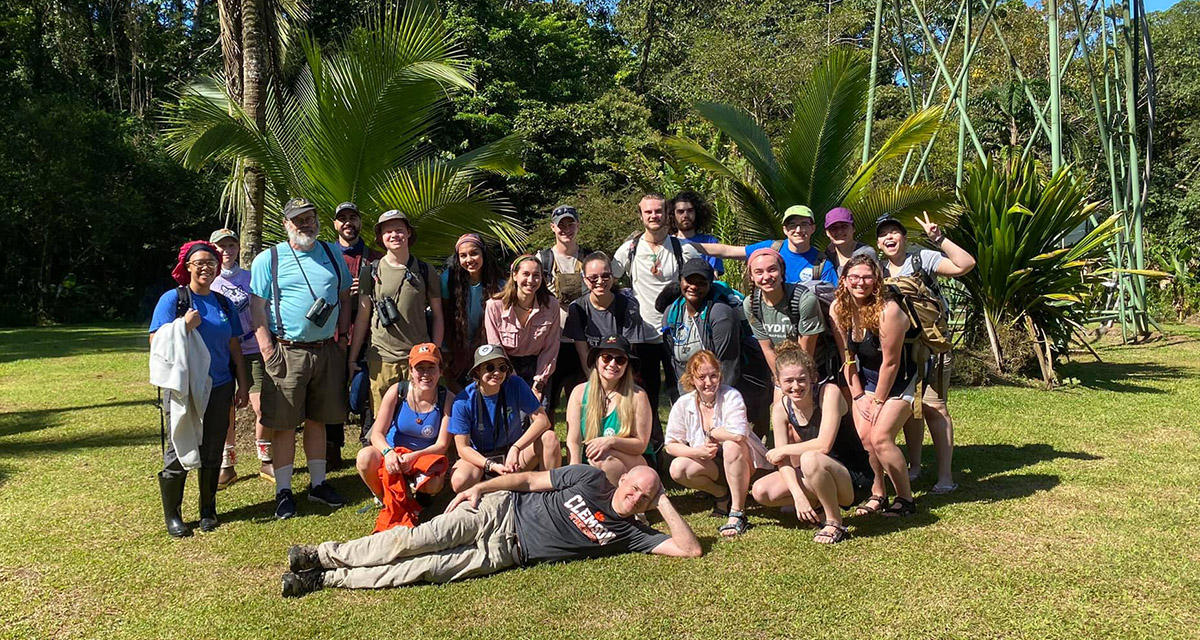 The 2022 Costa Rica Spring Break study abroad group
The 2022 Costa Rica Spring Break study abroad group To learn how this journey into study abroad began and to document the many memorable trips, FNR sat down with Dr. Dunning to get the full story.
Let’s start at the beginning. Tell us about your study abroad experience in Mexico that was such a seminal event for you that now, decades later, you are still studying abroad.
I grew up in a suburb of Akron, Ohio. My family went to the ocean in New Jersey and took lots of vacations to Florida, but before I took this trip to Mexico through my undergraduate college, I had never been West of Cincinnati, Ohio.
That original study abroad experience consisted of 40 or so students and a bunch of faculty jumping into university vans and driving to Mexico by way of South Texas. I saw the Gulf of Mexico and Padre Island National Seashore. I saw my first rugged mountains. I was a biology major, so seeing the tropical rain forests in the southern part of Mexico and the deserts and everything like that was mind blowing.
There were all sorts of personal experiences as well as educational experiences. I have to admit that I had never been in a place where I was the outsider. We went to markets where nobody spoke English and tried to negotiate buying food and that sort of thing. I also had never seen people begging on the street before.
The way the faculty of that trip ran the course was that we were in a caravan of vans, and when one of the leaders would see something interesting, he would use a walkie talkie to pull everybody over. We’d be out in the middle of the desert and they would just say, okay, meet back here in two hours, and they let everybody spread out and do whatever they wanted. Some of us would go birding, the botanists would collect plants, the insect people would collect insects, it was just a marvelous experience.
It was such an eye-opening experience that when I went off to graduate school at the University of Arizona, I went back the next summer and took the course again through my undergraduate college, but this time as a graduate student.
When did study abroad become more than just a student trip for you? When was your first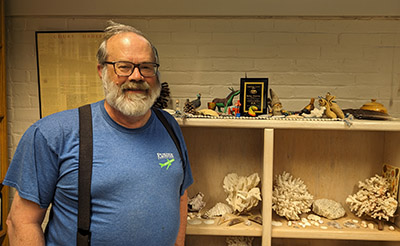 experience as a faculty member?
experience as a faculty member?
I joined the faculty at Purdue in 1994. Two years or so after that, a faculty member in the forestry group, Andy Gillespie, was interested in starting a course that would be taught collaboratively with the forestry faculty at the Swedish University of Agricultural Sciences, SLU. The very first year, the Swedes came over here and the topic was on forest management for oaks, because English Oak is a very important species in Sweden, but they have limited areas where it’s a dominant species. The Swedes were very interested in coming to see our forests where oaks were really important. They asked me to participate in leading a bird hike. We went up to the Lake Michigan shore and walked along the beaches there.
The next year, the course was going to be in Sweden and Andy asked me to participate. I don’t think I was officially a leader. I think I was just a groupie. But, after that second year, I became a full-time leader with that course. The course started here at Purdue and then went up into Michigan a little bit and ended up in the Smoky Mountains. One interesting part of FNR 46000 is that we call it a study abroad, but it has not always been outside of the United States limits, but there have always been European students enrolled through SLU and European faculty. So, there was always the experience of interacting with people from different backgrounds.
On a typical study abroad trip, a person like me gathers up a bunch of students from my program and we go someplace cool and we wander around as a group and we experience the cool place, but everybody in the program is from one school. The original idea for this trip was to have the Swedish students and the American students work together on projects, so it became an exercise in learning how to work with people from other cultures. Around the year 2000, Gary Blank of North Carolina State was at a professional society meeting and got to talking with Andy. The next summer he came along as a groupie and after that he started bringing students, so Purdue, NC State and SLU have collaborated most years since 2000.
Trent Osmon, 2023 FNR Distinguished Alumnus honoree, said he went with you on this study abroad trip when it was in Colorado in 1998, and again when it was in Sweden in 1999 and that those two very different experiences were fascinating for him. What do you remember about those trips specifically?
The first year that I was a full-time designated leader we went to Colorado. The whole course was designed by one of our faculty here with the themes of wildlife, national parks and wilderness, outdoor recreation, that sort of thing. My whole family went. My two boys were probably nine and six at the time, and my wife drove our personal vehicle with the kids and I rode with the students occasionally. The guy who designed the trip was from Colorado and couldn’t pass up anything that we might visit, so we spent way too much time at every location. My wife would just drive straight to where our next camping site would be and get there six hours before us.
We went to Mesa Verde National Park and to Rocky Mountain National Park. The Swedes are excited because they saw their first rattlesnake. Respectfully, from a distance. They also saw tremendous thunderstorms rolling across the Nebraska plains when we were all sleeping in tents in a campground in Nebraska, and they had never experienced thunderstorms of that nature in Sweden. That was very eye opening, especially since there were tornado warnings associated with the storm and it ended up with the entire group, probably 40 or so people, in the only concrete building in the entire campground, which was, of course, the restrooms.
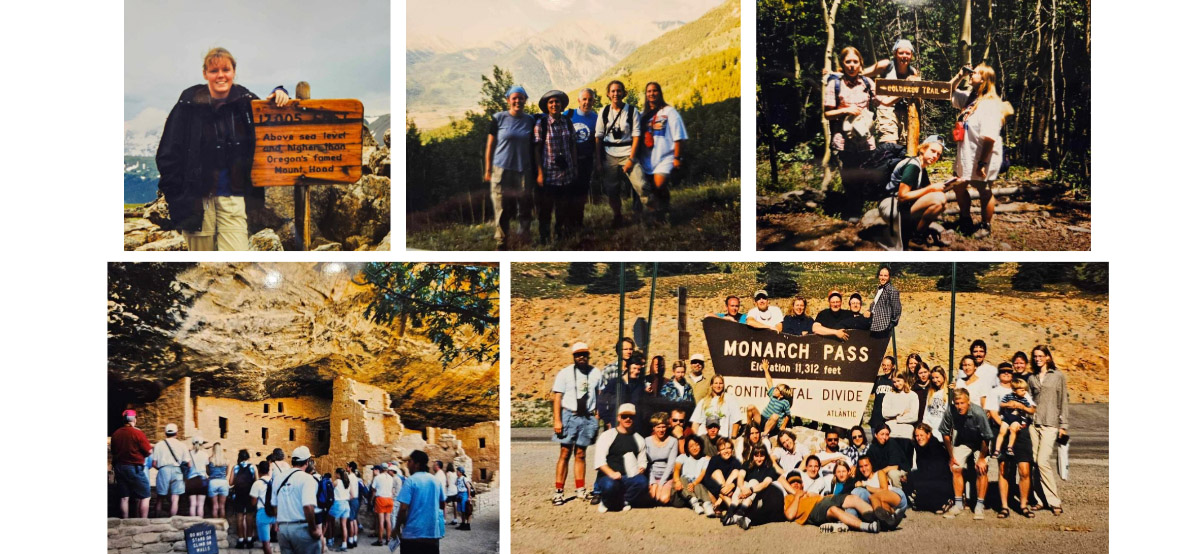 A collage of photos from a study abroad trip to Colorado, including photos at the Colorado Trail, Mesa Verde National Park and at Monarch Pass.
A collage of photos from a study abroad trip to Colorado, including photos at the Colorado Trail, Mesa Verde National Park and at Monarch Pass. You’ve made 21 trips with what is now called the International Natural Resources Issues study abroad program with SLU. Going to places multiple times can provide some monotony, but do you try to experience different places each year that you go?
We try to experience different places most years. For the longest time we alternated being somewhere in North America and somewhere in Europe. So, at the very least, from year to year, you're going to be in the Pacific Northwest one year and then you're going to be in Poland, in Germany the next year. We've done the Pacific Northwest several times, starting in Vancouver, British Columbia, and then going down into Oregon and Washington. We've been to the far northern part of Sweden to a national park called Abisko, which is 200 kilometers north of the Arctic Circle, three or four times. There are some places that we go back to because they're really, really cool and they have great teaching opportunities. But part of the attraction for the faculty in this course is that we've also been to Turkey, we've been to Estonia, we've been to the Yucatan and we've been to the maritime provinces of Canada, so it never gets old for us.
What are some of your top highlights from the collaborative trips with the Swedes?
Abisko National Park in the very, very northern part of Sweden is just an incredible place for hiking. It's one of the premier tourist destinations in Sweden in the summer just because it's so cool. Because you are 200 kilometers north of the Arctic Circle, the sun never sets much. The professor who led the course from the Swedish side for a long time, loved to say that we're going to be there for a month, but we'll only be there for one day because it never gets dark.
just an incredible place for hiking. It's one of the premier tourist destinations in Sweden in the summer just because it's so cool. Because you are 200 kilometers north of the Arctic Circle, the sun never sets much. The professor who led the course from the Swedish side for a long time, loved to say that we're going to be there for a month, but we'll only be there for one day because it never gets dark.
One of the highlights for a number of years was a backpacking trip to a lake where climate change research was being done. Several of the students, including one or two Purdue students, decided to hike over a mountain starting at 8:00 at night and arrive at the designated camping place the next morning, rather than leaving in the morning and walking during the day. They saw a wolverine while they were on the hike. And, of course, you could get lost because it's a wilderness area, but it's not like you're going to lose your way because it was dark, because it never got dark. We've seen really, really cool wildlife in that area.
Estonia was one of the most surprising countries that we visited during my time, in part, because I had absolutely no idea what to expect. Estonia had been part of the Soviet Union, and as we drove around with a woman from the National Water Agency, she pointed out what had been collective farms during the Soviet era. I was surprised to find out that none of our American students had been taught in high school what collective farms were. Their history courses don't cover that part of American history where we were in competition with the Soviet Union. But, we, the faculty, were all excited to see these buildings, some of which were big concrete blobs with no aesthetics whatsoever that were not being used and were falling into disrepair. But others had been purchased by local people, some were made into beauty spas and some were made into shopping malls. None of them were being used as farms anymore. So just to see the collective farms and drive around in an area that had that kind of history that I was familiar with growing up with, that was really cool.
I could talk forever about Turkey. My vision of Turkey was that it was scraggly hills covered with shrubs and little boys with groups of goats they were herding around. And we saw some of that. But, when we spent a month there, we also saw mountains near the Black Sea where I felt I was in western Mexico because the mountains were covered with jungles. I always thought of Turkey as being a hot country in the center part of the country, but we got to areas above tree line where it got so cold at night. There were places where you thought you were in Illinois or Colorado with massive fields of wheat being harvested by combines. There's an area called Cappadocia, where they have underground tunnel systems where Christians hid 2000 years ago when they were being persecuted. We went to a monastery that was built up on a hillside, a cliff face, 700 years ago, and at one point it was Christian and one point was Muslim and now it's a museum. The history of places like that were just absolutely amazing.
Here in the United States, I recall going to the Olympic National Forest in Washington and seeing our students watch the sunset over the Pacific Ocean, those who have never been out west before.
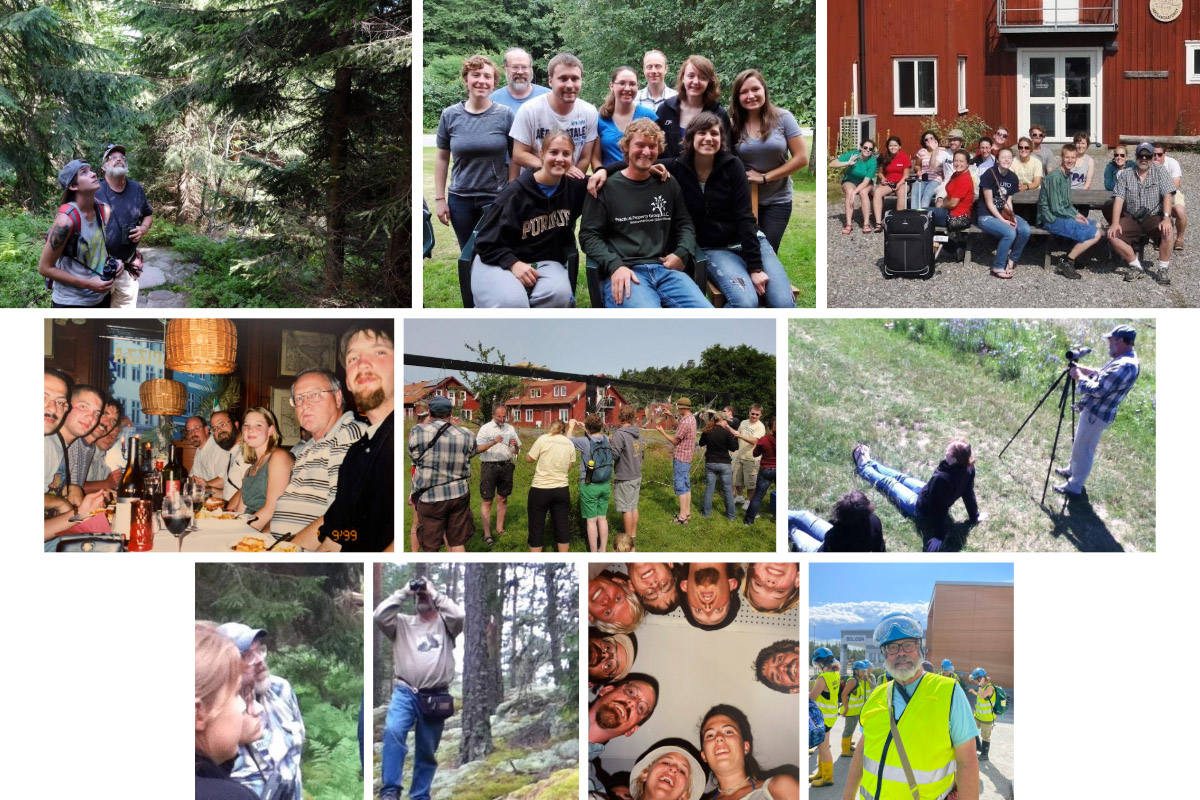 A collage of photos from study abroad trips to Sweden. Top row (left to right): Birding with Ashley Higdon looking for a very tiny bird called Goldcrest; group photos of Joni Kotterman (Willits) from the 2013 Sustainable Use of Natural Resources trip to Sweden, Germany and Poland. Row 2 (L to R): Trent Osmon (far right) and members of Sweden trip eat dinner; setting up a mist net in Sweden; Dunning standing with a scope. Row 3: Dunning talks with students; Dunning looks through binoculars; a group photo from Osmon's Sweden trip; Dunning wearing protective gear at a mine during the 2023 Sweden trip.
A collage of photos from study abroad trips to Sweden. Top row (left to right): Birding with Ashley Higdon looking for a very tiny bird called Goldcrest; group photos of Joni Kotterman (Willits) from the 2013 Sustainable Use of Natural Resources trip to Sweden, Germany and Poland. Row 2 (L to R): Trent Osmon (far right) and members of Sweden trip eat dinner; setting up a mist net in Sweden; Dunning standing with a scope. Row 3: Dunning talks with students; Dunning looks through binoculars; a group photo from Osmon's Sweden trip; Dunning wearing protective gear at a mine during the 2023 Sweden trip. Your background is in wildlife and it seems like one of the cool things about these trips is being able to see and experience it through someone else’s eyes, who is seeing things for the first time. What is it like seeing a student light up like that?
All of the students have to write a journal during the trip and then, at the end after a couple weeks have passed, they write a reflective essay. I was surprised two spring breaks ago when we went to Costa Rica, the number of students who commented on my reaction to seeing a cinnamon woodpecker, which is a really spectacular species of woodpecker that I had never seen before. It happened to be the first day of that particular trip, and I just got really excited about seeing that bird for the first time, and that was a reminder to me of how much they noticed when I was personally excited at seeing something like that.
I get excited by a lot of things, not just when it's something new for me. One of the nice things about the history of doing all these classes is that you know the kinds of things that are really going to get people excited. When we're in southern central Sweden, we go on a moose safari. They're very common in the landscape, but during the day when you're driving around, they're in the woods. You have to drive around at sundown, which is hard to do if you're north of the Arctic Circle where there is no sundown, but it gets a little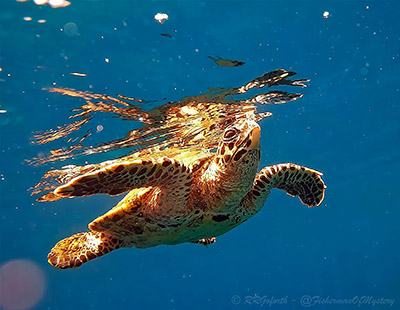 less bright at some point. So, we go out at 11:00 at night when we're a little further south and when it is starting to get dark, we just drive around and see how many moose we can see. The students are really excited by the prospect of seeing one or two moose – we have seen as many as 12.
less bright at some point. So, we go out at 11:00 at night when we're a little further south and when it is starting to get dark, we just drive around and see how many moose we can see. The students are really excited by the prospect of seeing one or two moose – we have seen as many as 12.
In Costa Rica, it's often monkeys that are really exciting to the students. We get a fair number of aquatic science students who go on the Costa Rica trip and they want to see sharks and sea turtles on the day that we go snorkeling. We usually do that and you just know that's something they're going to remember from the trip for their entire lives, anticipating seeing some of these things and then actually going and seeing them.
What is one experience or standout moment that you recall from your time on the Swedish trips?
Our Swedish course takes up the month of July, which means we're there on the 4th of July, which actually is not celebrated in Sweden. There was one time our Swedish colleague managed to find fireworks and so we went out late in the evening on the 4th of July and tried to shoot off fireworks. Well, first off, it didn't work very well because it wasn't dark. And secondly, what he really managed to do was catch fire to a neighboring hayfield and the farmer came roaring up to see what we're doing, so that was not great. We were able to put the fire out.
On the other hand, there was another time at Abisko National Park in the very far north, there's a ski lift that you can take to the top of a nearby mountain. In the summer, they take hikers up there and then you hike back down to the place that we're staying. There's a small restaurant at the top of the ski lift, and we went up at midnight on the 4th of July, and the restaurant served us reindeer pitas for dinner. So we were all sitting around in pretty sunny conditions, in my case watching some really cool birds go by, and eating reindeer on the tundra on the top of a mountain, so that stands out.
You’ve made eight trips to Costa Rica. Tell me about your first trip in 2014. How did that come about?
Reuben Goforth had been offering what started out as an alternative spring break experience. Initially, he took three or four students to one location in Costa Rica and they helped him collect data on freshwater fish populations and he taught them how to do research. After he'd done that for three or four years, it had gotten up to eight or nine students and he realized he had to change his format. He couldn't do individualized research with that many people, and there was a lot of demand for the course, so he approached me about coming to help build his course into a more generalized natural history class, which would allow us to double the number of students.
We take 18 or 19 students now rather than eight or nine. He came to me because he knew I did a lot of study abroad, but also because it's perfectly obvious when you get down in the tropics that you're going to need somebody whose expertise was something different than Reuben’s. He knows the herps really well and he obviously knows the fish. You need somebody who knows the birds because you see so many more birds. This past year, we saw 294 species of birds and I think we saw 21 species of mammals. That's not to say there aren't any mammals down there, it's just that they're nocturnal, so you just don't get to experience them as well. You could easily argue you could bring an entomologist or a botanist because we see hundreds of different kinds of insects and plants.
Going to the tropics is very different than going to Sweden and north of the Arctic Circle. What opportunities does Costa Rica bring?
opportunities does Costa Rica bring?
That's the interesting thing about Costa Rica is that people think it's just tropical, but there are so many different ecosystems. The vast majority of American students, when they think of tropical habitats, think of tropical rainforests, even though we teach them about and show them pictures of tropical dry forests in the courses they take, but it doesn't resonate until you actually get there. There's a big mountain range that goes down the center of Costa Rica, and it's very different on the Caribbean side than it is on the Pacific side. On the Caribbean side, it's much wetter, so you get tropical rainforests there. But, on the Pacific side, you get tropical dry forests or scrub forests. Not only are the species of plants different, but the whole growth form. The forests look different on the other side. There are a lot of differences in the fish and the amphibians and the birds between the Caribbean side and the Pacific side. Then you also have the mountain ecosystem and faunas that are different than both. We only have ten days, but the advantage is it's such a small country that you can get to all of those in relatively small amount of time driving. You also have the Pacific Ocean and the Atlantic Ocean and you have the beach habitats and the mangroves and the intertidal. And you can go snorkeling and diving, so we have that component in each trip, too.
They've read about all this stuff and, of course, they get exposure to it in our courses too, but just seeing things for real that they've read about... A lot of tropical trees have extremely massive aboveground roots called buttresses. I think actually the Cathedral of Notre Dame has the same kind of structures and they're called buttresses there, too, and they're to help support the growth of the tree because the roots don't go down really deep. You can read about that, but then when you're sitting on top of one and you can actually see those structures, it's really, really cool. When we think of pollinators, we think of insects and bird, but there a lot of bats in Costa Rica and so there are plants specifically adapted to that. There are certain flowers and fruiting displays that are designed to be attractive to bats. There are so many things that are used as classical examples of adaptation that that you can actually see that it brings biodiversity to life for so many of the students.
Tell us about your top five experiences, places, whatever in Costa Rica.
There is an ecolodge up in the mountains. The first time we went there, there was an overnight low of 32 degrees Fahrenheit. We were not dressed for that at all; people were wearing every single thing they owned. We went out that first evening and saw an amazingly cool species of owl that I had never seen before called the Bare-shanked Screech Owl. Just being in a tropical nation like Costa Rica and getting to a place where the living room has to have a fire in order to keep everybody toasty warm at night was really amazing.
I can’t go snorkeling very well because of the beard, but I know the students are amazed at the diversity of color and life that you see on the coral reefs of the Pacific coast. This last year, we saw some coral bleaching, which they recognized and it was sad for them, because that is a major ecological story going on and they were seeing it for real.
How do you plan the locations to ensure the students experience all of the ecosystems and also the cultural diversity of Costa Rica?
It is almost exclusively Purdue students and faculty on this trip. Carlos Chavarria designs the trips for us and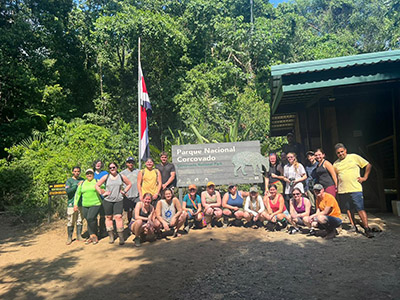 does all of the logistics, and then there is the guy who does the driving, a little guy named Jose who the students end up being very fond of. Carlos is a bat biologist. He has a long history of working with government agencies and field stations and has a lot of contacts. We don’t stay in the hotels in the middle of town. We are almost always staying in places where we are the only people except for the people who run the field station, those who are doing the cooking and cleaning, etc. The last two years we’ve had a group of students who knew Spanish well. They very quickly started talking with the support staff there and the people in the kitchen ended up bringing them in and showing them how they made different dishes while trying to communicate in Spanish because the staff spoke no English at all.
does all of the logistics, and then there is the guy who does the driving, a little guy named Jose who the students end up being very fond of. Carlos is a bat biologist. He has a long history of working with government agencies and field stations and has a lot of contacts. We don’t stay in the hotels in the middle of town. We are almost always staying in places where we are the only people except for the people who run the field station, those who are doing the cooking and cleaning, etc. The last two years we’ve had a group of students who knew Spanish well. They very quickly started talking with the support staff there and the people in the kitchen ended up bringing them in and showing them how they made different dishes while trying to communicate in Spanish because the staff spoke no English at all.
The students do get some interaction with other people such as when we stop at grocery stores and gas stations and that sort of thing, but it's more self-contained than with the summer course. There are large contrasts, especially if you get out of San Jose, between what a Costa Rican city or town looks like and what our cities and towns look like. Large sections of San Jose probably look like fairly nice sections of California mountain towns near the beach, but when you get into the smaller towns, it's metal roofs on buildings that were clearly cobbled together with whatever building materials were at hand. What the students often comment on is that it appears that people in Costa Rica in many areas are much poorer than people in the United States, but they're happier.
Are there any lasting impressions you have taken with you from these trips?
The last few years I've been doing this somebody said “I learned a lot about me and what I appreciate and what I don't appreciate and I have a new appreciation for home, but also for the broader world out there.” I think that's the general gist of what this Legendary Leaders Award is about.
There was one student in our program that I encouraged to come the year that we went to Turkey, around 2003. This young lady now would get a lot more support for mental health than we recognized was needed back then. She finished her program, got her degree and she's been working in the field, but she struggled a good amount, in part due to lack of self-confidence but also some other mental health kinds of issues. So we're hiking up this trail in the mountains of Turkey, going to that 700 year old monastery up on the cliff face. I was walking behind her and she turned around and quietly said, “six months ago, if you'd asked me, I never could have imagined myself being in a place like this.” And that's what you hope for, that not only are people getting a really cool experience, but they recognize it at the time that this is really eye opening.
Just two months ago, I got an email from a student who had gone on the Costa Rica trip back in 2018, I think her undergraduate program was in chemical engineering. We've had people from a number of programs go on the Costa Rica trip, although it's mostly our own students and NRES. Anyway, she wrote to me with this video link. She's finishing a PhD in tropical ecology. She went to a university in Germany that has ties with a university in Indonesia, and her PhD project is going to incredibly remote parts of a national park in Indonesia, measuring a whole bunch of trees that had been measured five or 10 years previously and setting up a baseline long-term monitoring program where they can use this existing data to determine how much change was occurring in the national park and how much it's going to be changing into the future. The video was sort of a 20-minute travel log of what she's doing for her project and of the benefits of it and some of the constraints. She said “it was all because of your Costa Rica trip.” Her undergraduate program didn't have anything to do with ecology in general, much less the tropics, but she got excited enough by what she saw that it changed the whole direction of her life. You never know.
Students always get really excited by sloths, so we try to see a couple. There are two different species down there. Sometimes in the last half hour or so before we arrive at our first location on the very first day, we’ve seen sloths by the side of the road or along the telephone poles along the way, and everybody wakes up for that, even though we leave at 2 or 3 a.m. to drive to O’Hare and get on a plane to San Jose and it is now almost 10 p.m.
Just being able to walk out the door of the room where you slept during the night and hear black howler monkeys howling and see toucans and parrots and macaws there ... Several of the people who said they were not interested in birds are just amazed by how many different things you can see from the porch.
What They’re Saying About Dunning
“I could not be more appreciative for Dr. Dunning introducing me to ornithology and the curiosities of the bird world. Our adventure first began on a trip to Costa Rica, looking for the Resplendent Quetzal. This emerald and crimson colored bird is iconic to the tropical region. Needless to say, as I’ve learned, birds have a way of ‘just sort of… showing up.’ As the students were chatting in a small parking lot surrounded by forest, Dr. Dunning pointed out that the Quetzal was perched nearby. We got fantastic views. My love for birding continued to grow through additional study abroad trips with Dr. Dunning to Sweden, Germany, and Czechia.
“I believe we were in Czechia and Dr. Dunning and I were looking for a very tiny bird called Goldcrest, while hiking through one of many national parks. After several minutes of searching, we spotted it. Now seven years later, I am still learning, asking questions, and seeing new birds (lifers). Thank you, Dr. Dunning for your impact on my experiences both abroad and at Purdue.” – Ashley Higdon, Wildlife 2018
“I went on the Purdue Study Abroad to Sweden, Germany, and Poland in summer of 2013 for the Sustainable Use of Natural Resources in Baltic Sea Countries class led by Dr. Dunning. It was an experience of a lifetime and I was extremely out of my comfort zone traveling out of the country with no one that I knew well. I remember arriving at the airport by myself after flying to Sweden, a little scared and not knowing what to do, and, as I approached my gate, I saw Dr. Dunning sitting at the gate, sipping on his hot beverage and he had a milk mustache on his beard. I immediately felt comforted and was so grateful to have him there the whole trip. Congrats Dr. Dunning on your award for being a Legendary Leader!” – Joni Kotterman (Willits), Wildlife 2015
“I went with Barny to the Pacific Northwest/Canada in 2018 along with folks from NC State and Sweden. I can’t remember who had the idea but we introduced the Swedish students to s’mores and it was one of the best nights of the trip. Barny was great throughout the trip, always a very welcoming and warm man. I went out birding with him as an extracurricular activity. I went with him during class, practicum, study abroad, and once or twice on my own time. I always learned something and enjoyed myself.
can’t remember who had the idea but we introduced the Swedish students to s’mores and it was one of the best nights of the trip. Barny was great throughout the trip, always a very welcoming and warm man. I went out birding with him as an extracurricular activity. I went with him during class, practicum, study abroad, and once or twice on my own time. I always learned something and enjoyed myself.
“The last photo is our group from Purdue on his last day of the trip - I’m in the blue shirt next to him, and, if my smile doesn’t convey it, he was one of my favorite people at Purdue. He deserves all the awards and flowers because he is an amazing person.” - Kat Tessero, General Agriculture 2019
“I went with Barny to Abisko, Sweden and to Turkey. I remember Sweden as my first study abroad with Dr. Dunning as I pursued Ornithology. The Abisko, Sweden, area had daylight almost 24/7 and I remember doing a lot of birding in and around the area, and Lake Torneträsk. We visited Abisko National Park and enjoyed camping and the sauna next to a small lake. In Turkey, we traveled from Istanbul to Trabzon and did birding along the Black Sea. We then traveled to Cappadocia, before heading to Antalya. I valued my time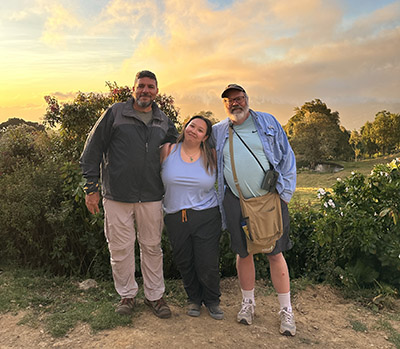 with him as he was the link for me transitioning into Ornithology.” – Paul Brooks, Natural Resources and Environmental Sciences 2006
with him as he was the link for me transitioning into Ornithology.” – Paul Brooks, Natural Resources and Environmental Sciences 2006
“Last spring break I was fortunate to experience the natural beauty of Costa Rica with Dr. Dunning and it was a pivotal moment for me and my career in natural resources. I easily saw over 100 different birds. I had never been particularly interested in birds, but after spending that week with Dr. Dunning, I became quite the bird enthusiast! Everywhere I go, I'm always on the lookout for what birds I can ID. I learned so much from Dunning, and Costa Rica has easily been one of my favorite memories during my time at Purdue.” – Tam Tran, current undergraduate student
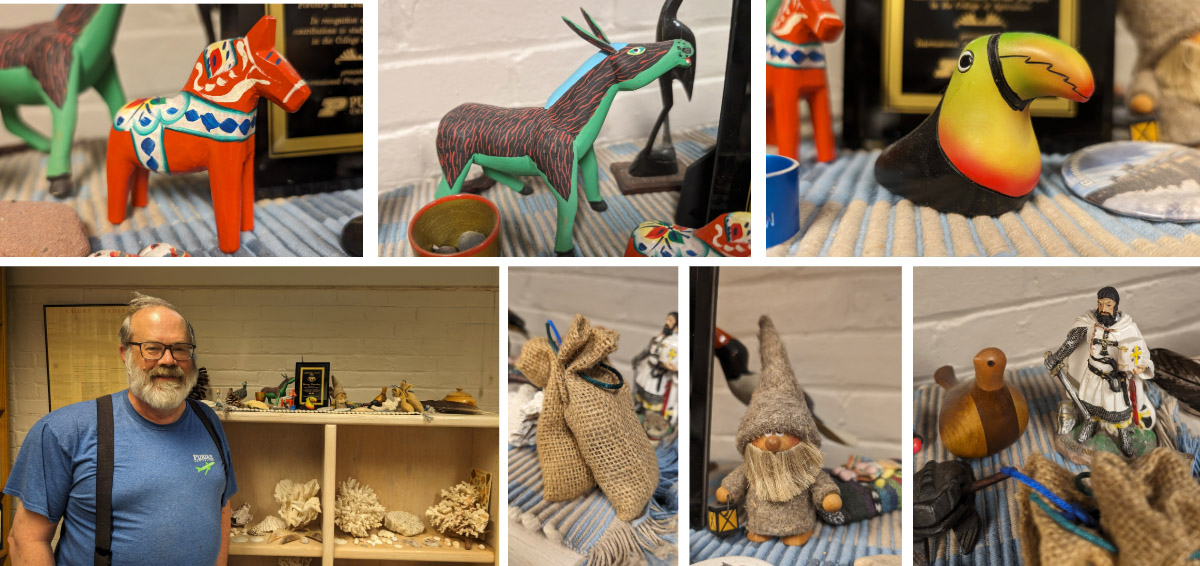 Dr. Barning Dunning and collectibles from his various trips abroad including a gnome from Estonia, a knight from Germany, bags of cacao from Costa Rica and more.
Dr. Barning Dunning and collectibles from his various trips abroad including a gnome from Estonia, a knight from Germany, bags of cacao from Costa Rica and more. 





